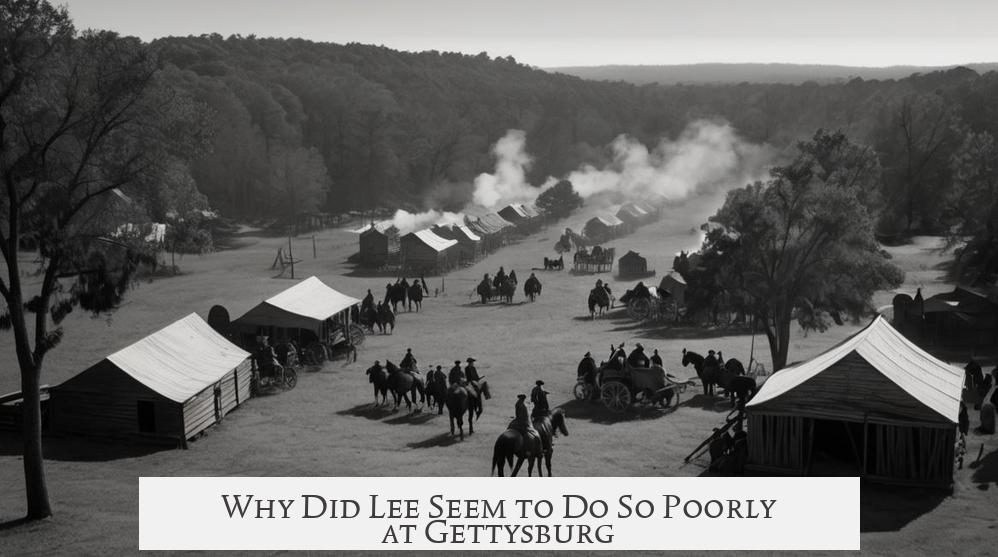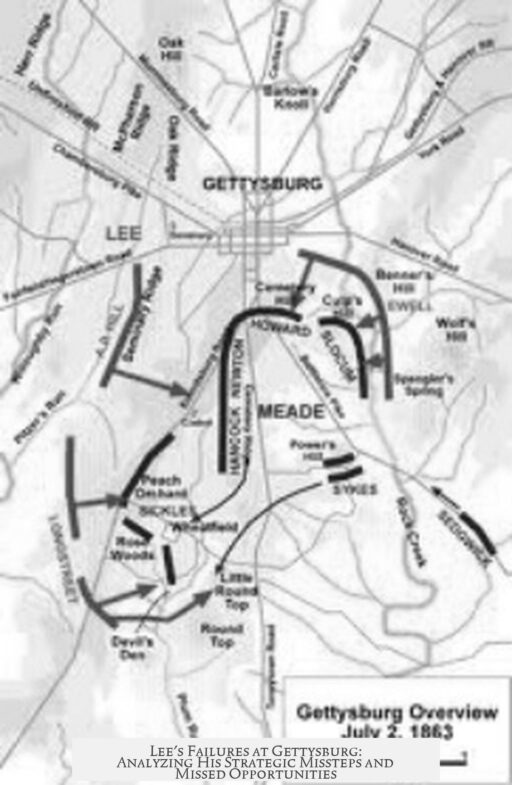Lee seemed to do poorly at Gettysburg due to strategic miscalculations, coordination failures, overconfidence, and logistical difficulties, all of which compounded to result in a significant Confederate defeat.
Lee’s strategy for the Gettysburg campaign maintained his offensive approach previously demonstrated in the Antietam campaign. His goal was to threaten the Northern capital, Washington DC, in an effort to draw Union forces away from the South, strengthen Confederate bargaining positions, and possibly pressure the North into a peace settlement. Despite this offensive intent, Lee faced critical choices in maneuvering and battle execution that affected the outcome.
One major aspect of Lee’s seeming poor performance was his rejection of alternative strategic maneuvers proposed by his subordinate, General Longstreet. Longstreet suggested positioning Confederate forces south of Gettysburg, placing the army between the Union forces and Washington DC. This tactic would have forced General Meade to attack Lee’s strong defensive position, thereby shifting momentum in favor of the Confederates. Lee chose to engage directly, a departure from his earlier caution observed at engagements such as Cheat Mountain, where he avoided assaulting strong defensive positions.
By the end of the second day of fighting at Gettysburg, Lee had gathered important intelligence on Union positions. He had observed the Union army’s resilience and effective recovery from General Dan Sickles’ misplacement of troops forward, which initially weakened the Union line. He also noted the significant shortcomings in Confederate assault coordination, particularly the failure to execute simultaneous attacks on both Union flanks. This disjointed timing reduced the overall Confederate offensive strength.
Lee’s decision to launch the massive assault on the Union center on the third day, famously known as Pickett’s Charge, disregarded these coordination problems. While the attack was daring and demonstrated his traditional aggressive style of leadership, it ultimately led to devastating losses. The Union, having anticipated Lee’s strategy, set up strong artillery and infantry positions along Cemetery Ridge. Meade’s foresight proved decisive, as Confederate troops faced devastating cannon fire and entrenched infantry resistance during their advance across open ground.
Several larger strategic and logistical failures aggravated Lee’s predicament. The Confederate strategy assumed that the North would tire of war and sue for peace as a result of military pressure. However, this was a grave misjudgment. The North persisted in its war effort with determination, especially after defeats like Gettysburg and the concurrent Union victory at Vicksburg. The Confederacy’s overestimation of Northern war-weariness and underestimation of Northern resolve led to unrealistic expectations and sustained conflict despite dwindling Confederate resources.
Contributing to Lee’s poor performance was the absence of J.E.B. Stuart’s cavalry intelligence during critical moments. Stuart’s failure to gather timely information left Lee with incomplete knowledge about Union troop movements and strength. Lee’s conflicting orders to Stuart—to simultaneously gather intelligence and obtain provisions without clear priority—degraded the effectiveness of Confederate reconnaissance. Additionally, Lee’s army depended heavily on foraging, limiting its ability to stay in one location and complicating timely provision gathering, since foraging was impossible near enemy positions.
- Pickett’s Charge reflected a Napoleonic tactic, attempting to force a decisive engagement by attacking the enemy’s weakened center while pressure was maintained on their flanks.
- Meade anticipated this and positioned his forces to blunt the charge, resulting in massive Confederate casualties and failure to break Union lines.
Lee’s personal style also played a role. Known for his preference to engage rather than retreat, he persisted with aggressive action despite growing evidence for caution. His soldiers respected this fighting spirit, yet it contributed to costly decisions at Gettysburg.
| Factor | Impact on Lee’s Performance at Gettysburg |
|---|---|
| Rejection of maneuver | Missed chance to force Union attack from weaker position |
| Poor assault coordination | Separated attacks reduced Confederate attack effectiveness |
| Overconfidence and stubbornness | Refusal to disengage increased casualties |
| Misjudgment of Union resolve | Incorrect assumption North would seek peace sooner |
| Stuart’s absence | Lack of timely intelligence hindered Confederate decisions |
| Logistical constraints | Limited foraging and supply increased operational strain |
Lee’s seeming poor performance at Gettysburg thus stems from a combination of tactical errors, strategic miscalculations, and operational difficulties. His refusal to adapt plans based on evolving battlefield realities limited Confederate flexibility. Misjudging Union resilience and committing to frontal assaults without adequate coordination exacerbated Confederate losses. Logistical challenges further hampered his ability to maintain momentum.
While Lee’s reputation as a skilled commander remains, Gettysburg marks a major setback in his military career caused by a convergence of flawed assumptions and battlefield circumstances beyond his control. This defeat, along with other setbacks, directly contributed to the eventual failure of the Confederate war effort.
- Lee rejected maneuvering strategies that could have forced Union attacks on weaker Confederate positions.
- Poor coordination of Confederate assaults weakened offensive impact.
- Lee misjudged Union determination and strength.
- Stuart’s lack of reconnaissance deprived Lee of critical information.
- Logistical limits restricted Confederate army’s operational mobility.
- Pickett’s Charge was anticipated and repelled by prepared Union defenses.
Why Did Lee Seem to Do So Poorly at Gettysburg?

At first glance, Robert E. Lee’s performance at Gettysburg looks like a fiasco—marked by missteps, misjudgments, and a costly frontal assault known as Pickett’s Charge that failed spectacularly. Let’s peel back the layers on why Lee, who had been a brilliant commander before, seemed to falter in this pivotal three-day battle.
Lee’s Offensive Ambition: The Grand Plan
Lee’s campaign in Gettysburg mirrored earlier efforts, such as the Antietam campaign. The idea? Take the fight into Northern territory, pressure Washington D.C., and force the Union army off Southern soil. If the Confederacy could win on Northern ground, it might bump its bargaining power for peace. This was a bold, offensive gamble.
Lee’s trusted lieutenant, James Longstreet, had a different suggestion. He proposed Lee to occupy a strong defensive position south of Gettysburg, essentially cutting off Union forces from Washington, D.C. Longstreet’s plan was to force Union General Meade to attack on Lee’s terms. This approach played to Lee’s usual caution around strong defensive positions, something he respected and hesitated to attack blindly.
So why did Lee turn down Longstreet’s advice? That question is a key piece of the Gettysburg puzzle.
Missed Opportunities and Misjudgments
Lee was no stranger to defensive caution. Early in the war, he earned the nickname “Granny Lee” for avoiding risky attacks, notably around Cheat Mountain. Yet, at Gettysburg, after the first day, he chose to strike rather than maneuver. This raises eyebrows.
By the second day, Lee had some vital information. He saw General Dan Sickles make a risky move by pushing Union troops too far forward. The Union corrected that error quickly, reinforcing their lines and making their position stronger. Lee knew the Union had patched its weak spots and held a firm grip on high ground.
Despite this, Lee ordered attacks on both flanks that lacked coordination. The assaults did not synchronize properly, reducing their effectiveness. Coordination was *off*—a crucial flaw in executing a strategy that hinged on simultaneous pressure to break Union lines.
Then, on the third day, Lee gambled on Pickett’s Charge: a massive, direct attack on the Union center. It was supposed to be a knockout punch but tragically wasn’t.
Was Lee just stubborn? Quite possibly. He had a reputation for liking a good fight and hated retreat. His men admired his bold spirit and followed him loyally—sometimes into costly battles they might have avoided.
Strategic Failures Beyond the Battlefield
Lee’s problems went beyond tactics. His entire campaign rested on the hope that the North would tire of war and negotiate peace. This was a miscalculation. Historically, the North had seemed pliable in the face of Southern pressure—giving up compromises and tolerating conflict. But the Civil War wasn’t that kind of contest.
After Gettysburg and Grant’s simultaneous victory at Vicksburg, it was clear: Northern resolve was unshaken. The South’s strategy was dead in the water, yet the Confederacy pressed on, draining its dwindling resources.
One particular mishap was the absence of J.E.B. Stuart’s cavalry during critical moments. Stuart was supposed to scout and provide intelligence on Union movements. Instead, he went off on a “joyride,” leaving Lee blind to enemy maneuvers. Worse, Lee gave Stuart contradictory orders—both to collect vital information and to forage for supplies—without clear priorities, causing confusion and delays.
And then there’s the ever-present Southern army problem: supply lines. Lee’s army marched without solid supply routes and had to forage on the land. They couldn’t stay anywhere more than three to five days or run out of food. Gettysburg was fought under these tight constraints, possibly pressuring Lee into hasty decisions.
The Turning Point: Pickett’s Charge

Everything seemed to hinge on the third day when Lee ordered Pickett’s Charge. He hoped a massive assault on the Union center would crack Meade’s line.
But Meade anticipated this well. The Union artillery and infantry were dug in and ready. As the Confederate men marched bravely across open fields, they faced devastating cannon and rifle fire. Some even breached the Union line and engaged in brutal fighting, but eventual failure was inevitable.
This attack exemplified a classic Napoleonic strategy known as the “Strategic Battle.” The defender weakens the center to bolster the flanks. Lee’s hope was that the earlier Confederate attacks on the Union’s flanks would force Meade to thin his center. Meade didn’t fall for it.
What Can We Learn?
Lee’s poor showing at Gettysburg underscores how even brilliant generals falter when tactical audacity overshadows strategic caution. It also illustrates how intelligence failures, flawed assumptions about the enemy’s resolve, lack of coordination, and logistical constraints can undermine military campaigns.
So yes, Lee didn’t just “seem” to do poorly—he made several critical errors in judgment that turned Gettysburg into a Confederate disaster.
But it also invites us to ponder a deeper question: What would have happened if Lee had embraced Longstreet’s defensive proposal or had received reliable intel from Stuart? Could history have been rewritten, or was the Confederate failure inevitable given the broader strategic realities?
For those interested in military history or leadership, Gettysburg remains a rich case study. It teaches the value of adaptability, coordination, and the dangers of overconfidence—even for the most revered commanders.
Summing It Up
- Lee’s offensive strategy aimed to shake the Union and secure peace negotiations.
- He rejected Longstreet’s cautious plan for a strong defensive position.
- Failure to coordinate attacks on the second day weakened Confederate efforts.
- Misjudgment of Union strength and overconfidence led to the devastating Pickett’s Charge.
- Stuart’s absence deprived Lee of crucial intelligence.
- The supply limitations strained Lee’s campaign timing and options.
- The Confederate hope that the North would tire of war was badly misplaced.
Gettysburg is a reminder that battles are won not just by courage and boldness but also by timing, intelligence, and understanding your opponent’s resolve.
Why did Lee reject Longstreet’s plan to take a strong position south of Gettysburg?
Lee preferred an offensive approach over Longstreet’s suggested defensive positioning. He wanted to force a direct battle and believed pressing the attack might lead to a quicker resolution.
How did coordination problems affect Lee’s attacks during Gettysburg?
Confederate assaults on the Union flanks were not well coordinated. Attacks were launched separately instead of simultaneously, weakening their overall impact and giving the Union time to reinforce positions.
What role did Stuart’s absence play in Lee’s poor performance?
JEB Stuart’s cavalry was away gathering supplies and intelligence. This left Lee without critical information about Union troop movements, causing misjudgments in planning and timing.
Why was Pickett’s Charge a failure despite initial advances?
The Union was well prepared with strong defenses and artillery. Although Pickett’s men reached the Union line, they suffered heavy losses under heavy fire and close combat, leading to a repelled assault.
How did Lee’s strategic assumptions contribute to the defeat?
Lee expected the North to grow weary of the fight and seek peace. This misjudgment led him to continue offensive campaigns despite diminishing Southern resources and rising Union resolve.




